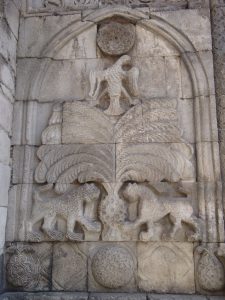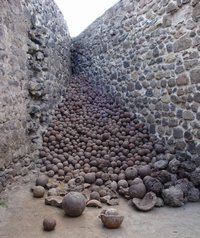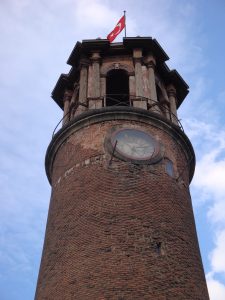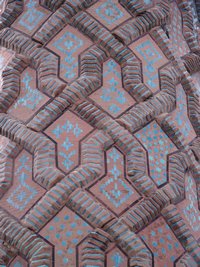Turkey’s coldest town? Population: 455,000
 In the northeastern corner of Turkey, Erzurum has an unenviable reputation as one of the coldest places in the country — 40 degrees below in winter, as the taxi drivers will delight in telling you.
In the northeastern corner of Turkey, Erzurum has an unenviable reputation as one of the coldest places in the country — 40 degrees below in winter, as the taxi drivers will delight in telling you.
Given that the local stone from which most of the older buildings were made is also a dour dark grey and it’s easy to imagine how it’s often thought of as rather a grim place, not somewhere that would top most people’s list of ideal holiday destinations. Nevertheless, for anyone interested in how modern Turkey came to be, this is a town with a venerable history as one of the places visited by Mustafa Kemal Atatürk during the planning stages of the Turkish War of Independence.
Don’t leave town without:
- trying cağ kebab, lesser-known cousin to the döner kebab which is roasted on a horizontal spit
- buying something made out of oltutaşı from the Rüstem Paşa Bedesten
Around town
 It may not be the most obvious place to start an exploration of Erzurum but to make sense of its many-layered history you should probably head straight for the Kale (Castle) which dates back to the fourth century and the reign of Theodosius II, the same Byzantine emperor who was responsible for the İstanbul city walls.
It may not be the most obvious place to start an exploration of Erzurum but to make sense of its many-layered history you should probably head straight for the Kale (Castle) which dates back to the fourth century and the reign of Theodosius II, the same Byzantine emperor who was responsible for the İstanbul city walls.
If you climb up the clocktower, whose upper part dates back only to a Russian occupation of the city in the 19th century, you will be able to gaze out over the sprawl of modern Erzurum and get your bearings while at the same time pondering the fact that its name is probably derived from the Arabic Arz ur-Rum, meaning the Land of Rome, an acknowledgement of its location on the eastern fringes of the Byzantine (Roman) Empire.
Aside from the castle, most of the main sites of historic interest stand on or around Cumhuriyet Caddesi, the main drag.
Descending from the castle you’ll come out close to the lovely Çifte Minare Medresesi (Seminary with Twin Minarets), probably commissioned in 1253 by Hüdavend Hatun, the daughter of the Selçuk sultan Alaeddin Keykubad II; don’t forget to walk round the back and admire her ornate and lovely kümbet (tomb). The Medrese reopened as a museum in 2021 after comprehensive restoration. It mainly exhibits artworks taken from mosques in the area.
The Selçuks conquered Erzurum shortly after their decisive victory over the Byzantines at the Battle of Manzikert in 1071, although it was ruled for best part of a century after 1103 by the related Saltuk Turks whose founder, Ali ibn Saltuk, is buried in the most imposing of the Üç Kumbet (Three Tombs), a short walk behind the seminary.
Melik Mehmed, the grandson of Ali ibn Saltuk, was responsible in 1179 for the fine Ulu Cami that stands right beside the Çifte Minare Medresesi. When the great Arab traveler Ibn Battuta visited Erzurum in the 14th century he reported that much of it was in ruins as a result of a civil war. When the British writer Michael Pereira passed through in the late 1960s he too found the Ulu Cami in ruins. It has since been reconstructed in the familiar Selçuk style in which a forest of columns support a hall-like structure, giving the interior a completely different feel to the more familiar, centralised design favoured by the Ottomans.
The Ottomans didn’t leave much of a mark on Erzurum even though they governed it from 1515 when Selim the Grim seized it from the İlhanid Mongols whose main gift to the city was the Yakutiye Medresesi, commissioned by the then ruler Ölcetu in 1310. It now houses the city’s small Museum of Islamic and Turkish Arts (closed Mondays).
 The Yakutiye is a stunningly beautiful building, its stunted minaret coated with turquoise tiles, its portal an exuberant mass of carvings, amongst them paired stone lions sitting beneath eagles that appear to be ducking to avoid being hit by snowballs. The contents consist of a pleasing, if dusty, collection of ethnography; it’s worth coming in anyway to admire the carvings over the low doorways that open off the central courtyard and to examine pictures of Erzurum as it used to be.
The Yakutiye is a stunningly beautiful building, its stunted minaret coated with turquoise tiles, its portal an exuberant mass of carvings, amongst them paired stone lions sitting beneath eagles that appear to be ducking to avoid being hit by snowballs. The contents consist of a pleasing, if dusty, collection of ethnography; it’s worth coming in anyway to admire the carvings over the low doorways that open off the central courtyard and to examine pictures of Erzurum as it used to be.
What the Ottomans did leave Erzurum was the so-so Lala Mustafa Paşa Cami, built for the notoriously violent and vindictive conqueror of Cyprus who served for a time as the local governor. Dating back to 1536, it was once thought to be a work of the famous Ottoman architect Sinan, although few people subscribe to that theory these days.
The Ottomans also left the 16th-century Rüstem Paşa Bedesten, a trading centre commissioned by the same Rüstem Paşa who bequeathed a beautiful mosque to the Tahtakale area of İstanbul and who was grand vizier and son-in-law to Sultan Süleyman the Magnificent. Today it serves as a showcase for beautiful jewellery and tespihs (rosaries) made from oltutaşı (obsidian) which is mined in Oltu, a village 116km north-east of Erzurum. Fine examples of antique oltutaşı are on display in the Museum of Islamic and Turkish Arts.
The 21st century has not been kind to Erzurum when it comes to architecture, and the high street, Cumhuryet Caddesi, is a kaleidoscope of clashing colours and designs.
A brisk walk east brings you to a roundabout with a fountain in the centre that calls itself Havuzbaşı. From there head south along Yenişehir Caddesi to the Archaeology Museum (closed Mondays), which houses finds from local digs; the most recent exhibits are from sites excavated during the laying of the Baku-Ceyhan oil pipeline. Especially impressive is a huge clay pot from Patnos, near Iğdır; look closely and you will see tiny images of hunters and wild animals incised into the sides even though it’s thought that storage pots such as this were buried up to their rims in rooms adjacent to Urartian palace kitchens. (In 2023 this museum moved to a new site which I am yet to visit.)
As you wander back along Cumhuriyet Caddesi, detour north down a few steps beside a dreadful concrete sculpture of a samovar to look at one of Erzurum’s finest surviving 19th-century mansions. This was where Atatürk convened the first Turkish National Congress to discuss plans for a republic in 1919 and it’s now a small Atatürk Museum.
A little further west and a road south wanders past the Hacı Bekirzade Ağa Efendi Konağı, a stone mansion dating back to 1912 and covered with elaborate carvings unlike anything else in Erzurum.
If you poke about in the back streets around the castle you will also come across some old stone houses in an abject state of decay; the success of the Erzurum Evleri, a ramshackle collection of old houses with huge inglenook fireplaces and courtyard fountains that now houses a restaurant, has spawned the copycat Daşhane and Çifte Minareli restaurants, offering hope that the locals are belatedly waking up to the value of the remaining old buildings.
Erzurum had a short-lived economic boom in the 18th century when several identikit mosques were erected around town; today drinking water still gushes pleasingly from çeşmes (fountains) in front of them.
With time on your hands you might also want to visit one of the local hamams (Turkish baths); best are the Boyahane, Muratpaşa and Kırkçeşme baths although only the latter admits women and that rather reluctantly.
Shopping
The most obvious shopping excursion in Erzurum has to be to the Rüstem Paşa Bedesten to shop for jewellery made from oltutaşı. Be careful not to be fobbed off with black plastic though.
Other than that you may be surprised to see a branch of the upmarket İstanbul clothes shop Vakko right beside the Ulu Cami. Facing it across the road is a branch of the equally unlikely Şekerci Cafer Erol, a wonderful İstanbul sweetshop that sells delightful sugared almonds, marzipan shaped like Turkish fruit and veg and tiny pastry “nests” filled with nut eggs. You won’t be able to resist buying something.
Sleeping
Erzurum has plenty of decent accommodation although as yet nothing boutique or of historic interest.
Esadaş Otel. Tel: 0442-233 5425
Hotel Dilaver. Tel: 0442-235 0068
Otel Dede. Tel: 0442) 233 1191
Eating and drinking
On the edge of Kent Meydanı a strange-looking building with a glass tower on the corner houses the Cafees Cafe, a great place to come and meet local students and sip çay with a great view of the square. Upstairs the Samatya Cafe is the same but with karaoke.
Alternatively beside the Rüstem Paşa Hanı you’ll see the Müceldili Konağı, a restored stone house with a restaurant indoors and a cafe outdoors that’s a popular local hangout.
Erzurum Evleri Spread out through half-a-dozen old stone houses in a back street, the Ezurum Evleri is so full of ethnographic bric-a-brac that you’ll have trouble identifying the places to sit down and order food. Tel: 0442-213 8372
Güzelyurt Restoran This smart high-street restaurant with modestly curtained windows has been in business since 1928 and is a rare place in town that serves alcohol. Tel. 0442-234 5001
Transport info
Erzurum airport is to the west of town on the Aşkale/Bayburt road. There are regular flights from İstanbul and Ankara.
The otogar is way out of town near the airport. There are frequent buses to Trabzon, Kars and Iğdır (for Doğubayazıt).
Day trip destinations


